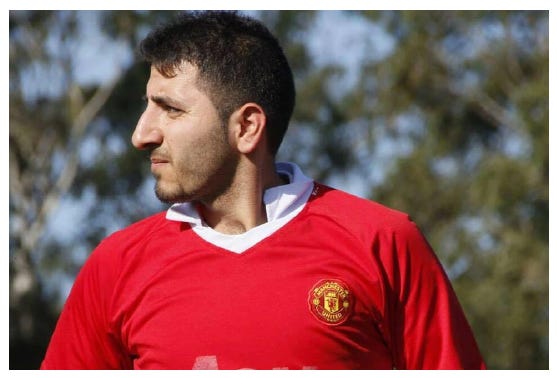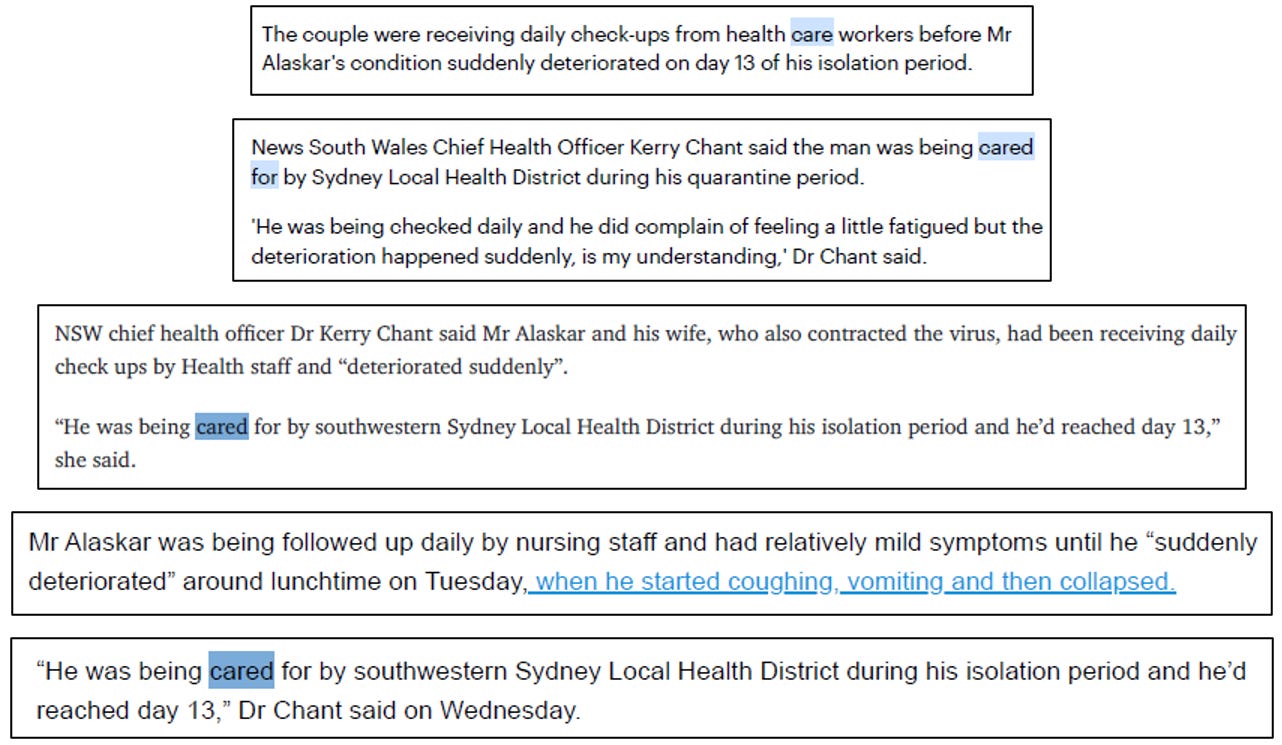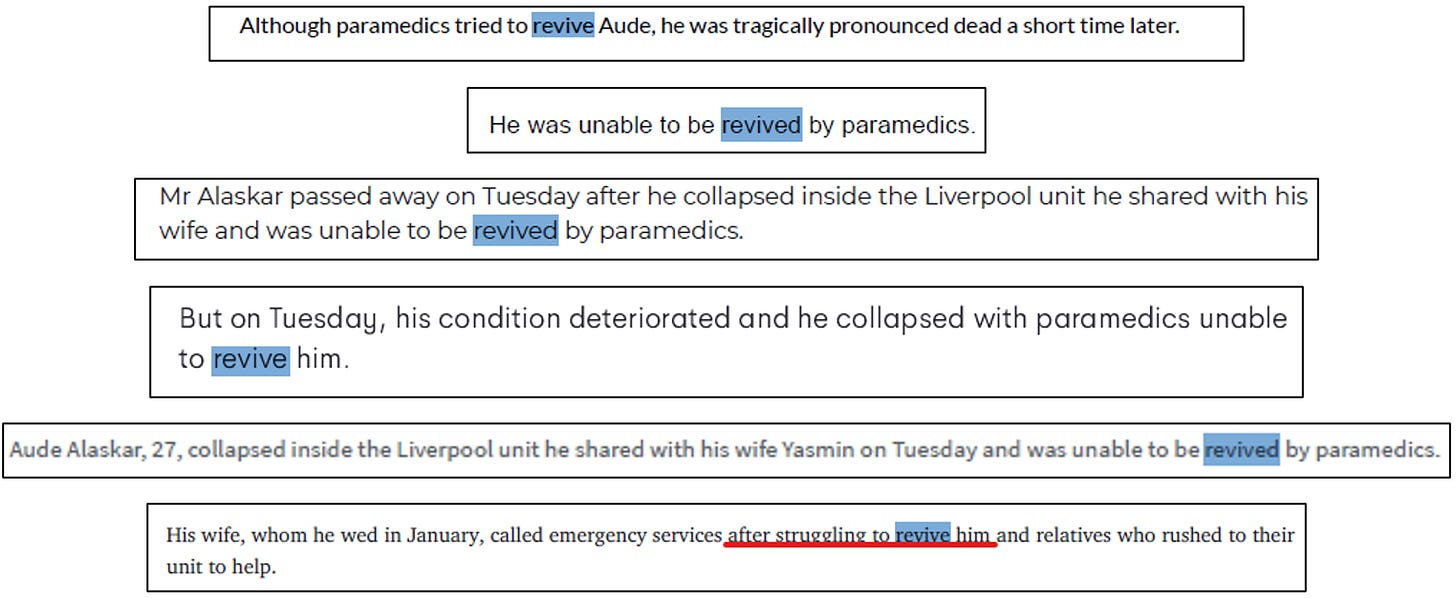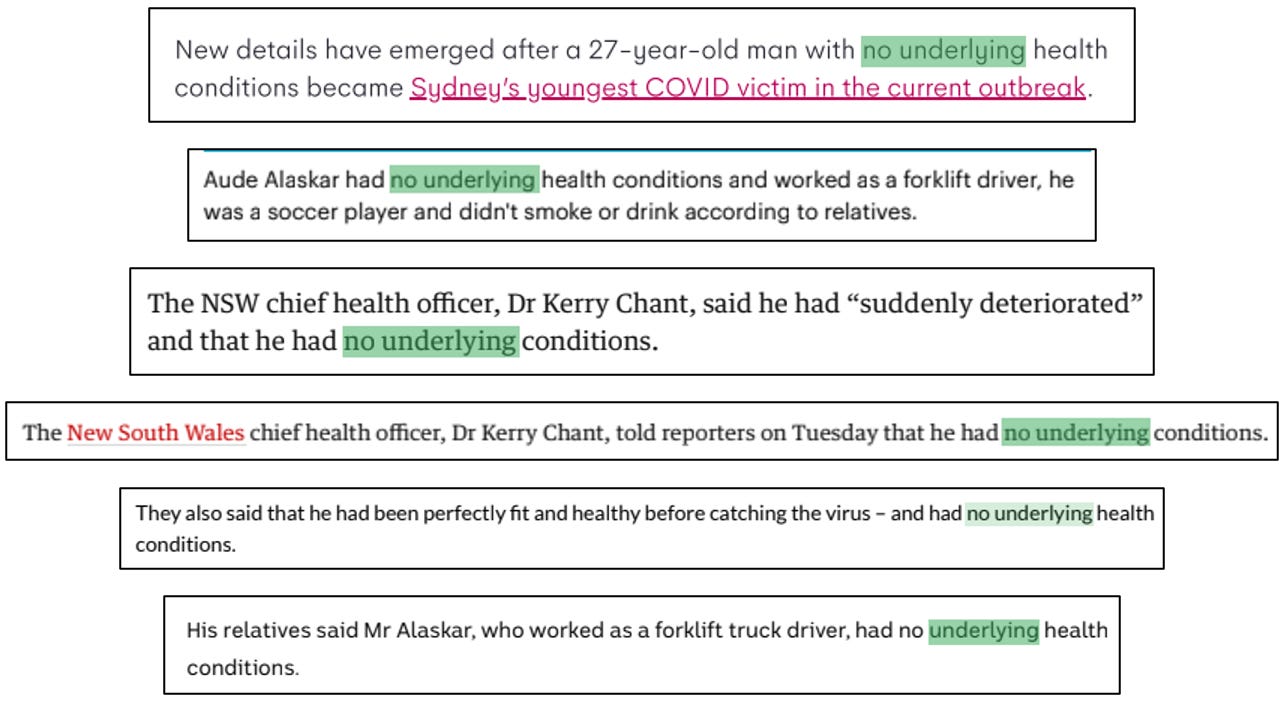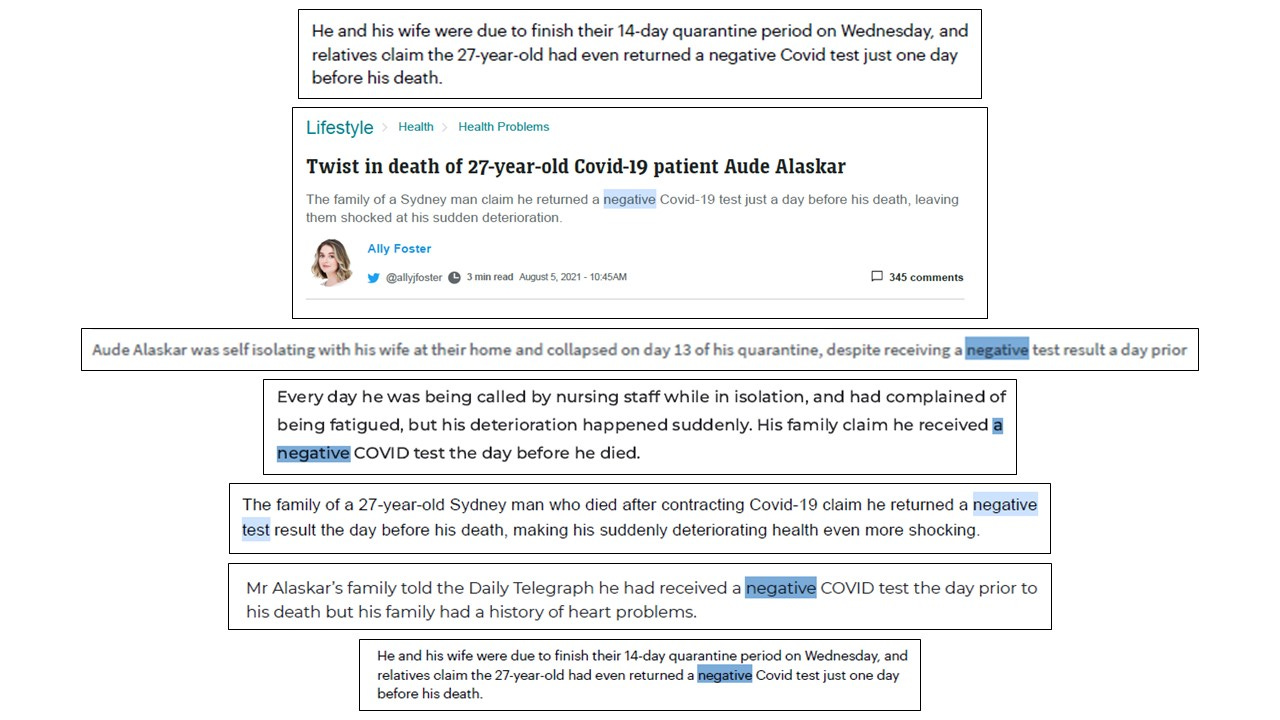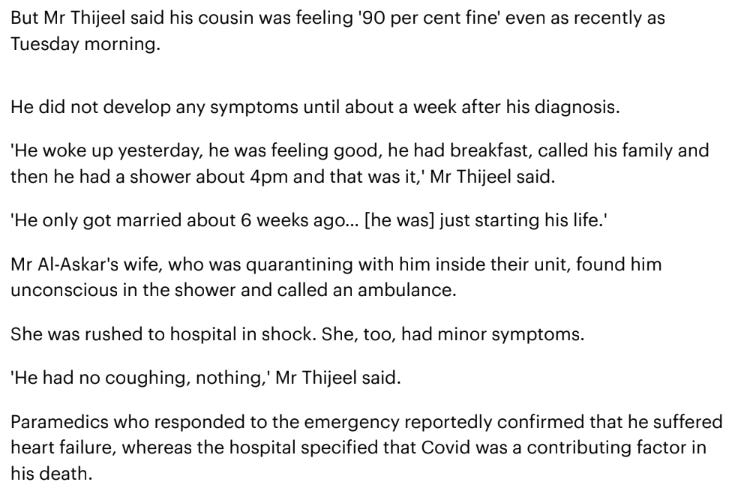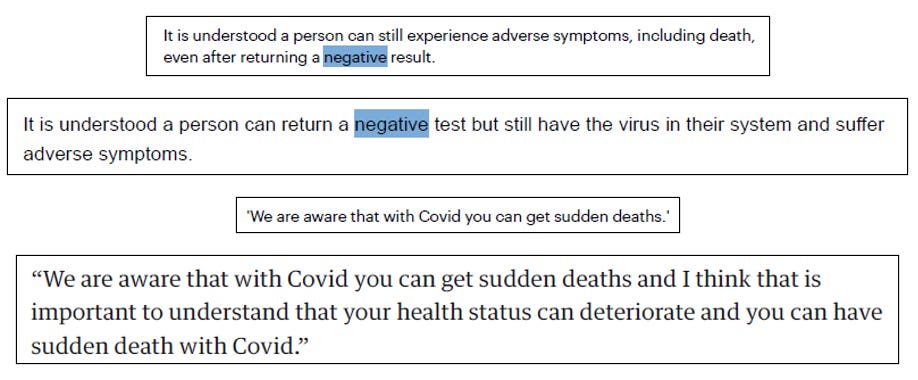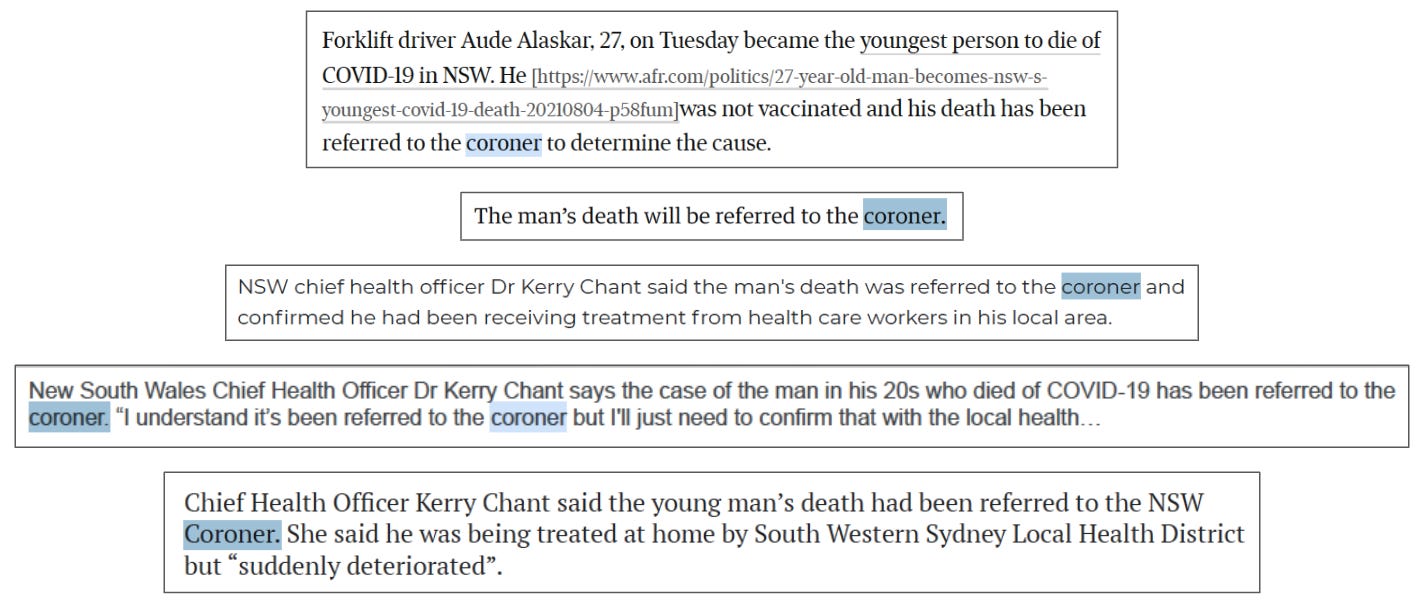Disinformation 101: What Really Happened to Aude Alaskar?
A case study in manufacturing lockdown consent through mass media propaganda
Aude Alaskar was a 27 year old, “unvaccinated” man who died in his South-Western Sydney home on 3 August 2021.
At the time, he was the nation’s youngest “COVID-19 death”.
His death was shamefully exploited to terrorise citizens about the alleged lethality of COVID-19.
In this article we analyse the disinformation following Aude’s death designed to stoke fear, incite panic and terrorise citizens to submit to “vaccination” and to justify the continuation of extreme and illiberal “public health” policies.
A note to my email subscribers, this post is too long for email and will be truncated by most email providers. Please access it via SubStack.
Who was Aude Alaskar?
This is what has been reported.
Aude came to Australia in 2011 as a refugee from Iraq.
He lived in Warwick Farm, a suburb in the southwest of Sydney known for its diverse and multicultural community, yet also for its social disadvantage, high unemployment and poorer health outcomes.1
It was also one of the suburbs that endured some of the harshest lockdown measures throughout 2021 in NSW.
About six weeks prior to his death, Aude was married to Yasmin.
Aude was a forklift driver, who was fit and healthy, never smoked or drank and played soccer for the Gunners Soccer Club in nearby Macquarie Fields.
Aude had no underlying health conditions.
He was unvaccinated.
He wasn’t an “anti-vaxxer” rather he was “not yet approved for his age group’s preferred vaccine [Pfizer]”.2 He had expressed willingness to be vaccinated, but, given his youth and concerns about the long-term effects of the COVID “vaccines”, was hesitant and therefore, was “not overly concerned about the extended wait times to get the jab”.
His hesitance was reinforced “after mixed messaging from the Federal Government which initially told Australians the AstraZeneca jab was not safe for people under the age of 60”3, advice which was later changed to “your available vaccine is your best vaccine”.
The circumstances of Aude’s death
This is what has been reported.
Both Aude and his wife Yasmin, a healthcare worker4, contracted the highly contagious Delta variant of the SARS-CoV-2 virus, with Aude’s infection reportedly confirmed on 21 July 2021.
As required by the public health orders in force at the time, they self-isolated at their home.
Aude had been in daily contact with the nursing staff from the southwestern Sydney local health district:
“He was being followed up daily by nursing staff and suddenly deteriorated. He was being checked daily and he did complain of feeling a little fatigued but the deterioration happened suddenly, is my understanding.”5
On Monday 1 August (day 12 of isolation), he reported a headache and not feeling well.6
At approximately 2:00pm the following day, Tuesday 3 August (day 13 of isolation), he began “coughing and vomiting” and took a shower where, between 2:00-4:00pm, he collapsed unconscious to be found by his wife:
“She found him in the shower on the floor, she fell on his body, she was shaking him so he would wake up ... he would not”
Unable to revive him, Yasmin called emergency services and relatives who rushed to their unit to help.
Paramedics were unable to revive Aude.
He died in his home.
The disinformation campaign
The disinformation following Aude’s death centred on five central themes:
Aude received appropriate care and treatment prior to his death
Aude had no underlying health conditions
Aude’s death was caused by COVID-19
Aude’s death was referred to the coroner
Disinformation and misinformation was spreading on social media in relation to Aude’s death
A small sample of mass media reporting from the time is referenced in this article and has been compiled into a .pdf document for reference. These do not represent the entirety of the reporting of Aude’s death, however, the compilation does include the major publications in Australia. Most, if not all of the articles are also still available online or via the Internet Archive.
Disinformation theme # 1: Aude received appropriate care and treatment prior to his death
It is presumed that the standard of care treatment given to Aude prior to his unexpected death was appropriate for his condition.
The reports make reference to how Aude was “being cared for”, with “daily check ups”:
However, Aude’s brother, Louie Alaskar described a different version of NSW Health’s “care and treatment” prior to Aude’s death:
“The health people let him down, they didn‘t do enough, police checked on him and his wife daily asking them to appear from the balcony, the health officials would just speak to him over the phone . . . The cops would come to the house every day and say ‘hi’ from the balcony and leave, the only help he got was from the nurses over the phone who would check and ask every day what his temperature was, how he felt, how they were both getting on”7 [emphasis added]
Many reports point to the suddenness of Aude’s deterioration, however, there are conflicting reports from Aude’s relatives about how sudden his demise was:
This report from Mr Thijeel suggests that Aude’s condition did indeed deteriorate suddenly.
In contrast, a cousin of Aude’s quoted in numerous reports circulating immediately after Aude’s death, indicated that there was more to the story regarding NSW Health’s treatment:
“We have a lot to say, we don’t want it to happen to anyone else, but now is not the time for that.”8
We contacted his cousin and he provided further information about how the care and treatment provided by NSW Health before Aude died:
Despite reports that Aude had “suddenly” deteriorated, we have a conflicting report here that NSW Health were made aware of his worsening condition and did not intervene:
It is also possible, though not confirmed, that NSW Health were aware of Aude’s worsening condition the day before he died, and chose not to escalate his treatment.
In either event, on the day he died, Aude was suffering to the extent that he and his wife thought it necessary to seek emergency medical care. After all, they were told “stay home don’t come” which is something that could have only been said to someone who was asking to go to the hospital.
Not only was he told not to come to the hospital, but that the hospital could not do anything.
He was told to not come to the hospital to receive the emergency care that he needed to potentially save his life.
Aude collapsed and died in the shower and, we are told, paramedics attended the scene and were unable to revive Aude:
The reports indicate Yasmin called emergency services after unsuccessfully trying to revive Aude and they were on the scene within minutes:
And these reports also seem to imply that the paramedics attempted resuscitation, however, Aude’s cousin claims that the ambulance arrived late “after he was dead”:
If the above story is accurate, it is little wonder Aude was unable to be revived.
Aude may have already died when he collapsed in the shower, and the delay between Yasmin trying to revive him before calling an ambulance, coupled with the time it took for the ambulance to arrive would have made paramedics “unable to revive [Aude]” because he may have been dead for some time and they simply did not try.
Ambulance performance data from July-September 2021 reveal that ambulance average response times from Liverpool averaged eight minutes for the “P1A Highest Priority” call-outs: “patients who are not breathing, in cardiac arrest or unconscious and not responding”. If Aude’s cousin’s account is accurate, it took almost twice as long as usual for the ambulance to arrive.9
The evidence presented here demonstrates that NSW Health were given sufficient advance warning of Aude’s deteriorating condition as he was told to stay home and not attend hospital. Aude must have been conscious when these requests were made to attend hospital because it was only after he collapsed that an ambulance was called.
Why was he denied emergency medical care?
Why did the hospital say there was nothing they could do?
In a pre-pandemic scenario, there might have been plenty the hospital could do. In September 2021, Australia’s Therapeutic Goods Administration (TGA) restricted access to potentially life-saving, repurposed medications that could have been used to save Aude’s life. It was well-established, even at the time of Aude’s death, that early treatments could improve COVID-19 mortality outcomes. A recently published retrospective analysis lends further support to the idea that there was that the hospital could have done had the TGA not intervened to restrict access to these life-saving medications. Added to this, had Aude not tested positive on his initial test, he would not have been discouraged from attending hospital and would have potentially received life-saving medical care.
The absolute majority of media reporting following Aude’s death portrayed a picture of Aude dying despite the excellent and attentive care he received to show just how devastatingly lethal and indiscriminate this virus was.
The reports never addressed how Aude was told to stay away from the hospital, left to die, alone in his home.
No doubt, this was disinformation crafted to serve two purposes:
Terrorise people with Aude’s death so that they would get vaccinated; and,
Ensure that legitimate questions would not be raised about the treatment protocols used by NSW Health in managing patients with COVID-19.
Disinformation theme # 2: Aude had no underlying health conditions
Reports following Aude’s death centred on his health and fitness.
He played soccer, neither smoked nor drank, worked as a forklift driver and had “no underlying health conditions” when he became Sydney’s youngest COVID victim at the time:
However, these reports were contradicted by relatives who claimed Aude had a history of heart problems:
Which were corroborated by other reports that Aude had died of “cardiac arrest” or “heart failure”:
A media story even sought the opinion of an esteemed Australian cardiologist for an article about what could have happened to Aude, implicitly acknowledging the likelihood of Aude’s existing heart problem, or other underlying health condition:
Aude’s death was framed by the mass media as the death of a fit, young and healthy man with no underlying health conditions despite evidence suggesting otherwise. Both the manner of Aude’s death and the reports from his relatives indicate that he was suffering from an underlying health condition of some sort, most likely a heart condition.
We acknowledge the evidence supporting this hypothesis is limited because it is reliant on a few early reports from Aude’s family and some media reports of his death by cardiac arrest or heart failure. However, the evidence that he did have an underlying condition is stronger than NSW Health’s repeated insistence, without proof, that Aude did not.
Our hypothesis is strengthened because Aude’s relatives are trustworthy and reliable. These same relatives are relied upon to provide the quotes and relevant details for the stories pertaining to Aude’s life and death, therefore, they can be trusted to provide an accurate account of the manner of his death and any possible health conditions he may or may not have had. Furthermore, these same relatives had spoken with Aude or his immediate family in the days prior to, the day of, and days following his death. Their account is, therefore, trustworthy and reliable.
In contrast, claims that Aude had no underlying health conditions qualify as disinformation: false information disseminated with the intention to mislead. It was propaganda intended to terrorise people so that they would get vaccinated to avoid this indiscriminate, lethal virus that could kill young people even without underlying health conditions.
Disinformation theme # 3: Aude’s death was caused by COVID-19
Abundant evidence contradicts the idea that Aude’s death was caused by COVID-19.
The negative COVID-19 test before he died: Aude reportedly had returned a negative COVID test the day before he died:
In a “low prevalence environment” like NSW was in August 2021, we have reason to believe that the negative test result would have been accurate.10
Aude’s condition was improving prior to his death: We also have reason to believe that his symptoms were mild and his condition was improving:
Aude and his wife both had mild symptoms and Aude even woke up on the day he died “feeling good”, “had breakfast, called his family” and then died at 4:00pm that day.
Several separate media outlets attempted to explain this apparent inconsistency in the early reports of Aude’s death about the negative COVID test result, assuring that “adverse symptoms” are still possible despite a negative COVID test:
To provide a more complete explanation of Aude’s death, several news stories then surfaced quoting COVID-19 “experts” who hypothesised how someone could deteriorate so quickly citing the “cardiovascular complications” from a COVID-19 infection, the clotting in the tiny vessels all through the lungs, pneumonia and “happy hypoxia”, or cytokine storm.11
We acknowledge the possibility of the role of one or more of these four potential complications in Aude’s death, however, we question how we could reconcile his sudden demise with the “mild symptoms” he had, improving to the point that, on the day he died, he was chatting with family after a morning breakfast describing himself as “feeling good”.
The evidence presented here suggests Aude may have died of something other than COVID-19, though we accept that COVID-19 might have been its antecedent cause. Despite the unexpectedness of Aude’s death, it was framed, unequivocally, as a COVID-19 death.
Once again, it was disinformation that was disseminated to incite panic that COVID-19 did not just kill the aged, immunocompromised or comorbid, but healthy, young and unvaccinated individuals.
Disinformation theme # 4: Aude’s death was referred to the coroner
In the immediate reports following Aude’s death, NSW Health said Aude’s death would be referred to the Coroner to determine the cause of death:
In NSW, a death is referred to the Coroner if it is:
sudden
unexpected
violent, or
the cause of death is unusual or unclear.
A death need not satisfy all criteria to be referred to the Coroner for investigation, and therefore, Aude’s death should have been referred because it was “sudden”, “unexpected” and because the “cause of death [was] unusual or unclear”.
NSW Health could contend it was entirely expected, usual and clear that COVID-19 could have killed Aude in the manner that it did, but they could not say Aude’s death was not “sudden”.
Aude’s death should have been referred to the coroner.
It was not.
We only learned of this when we contacted the NSW Coroner’s Court via email hoping to learn more about the investigation and determination of Aude’s cause of death. The NSW Coroner’s Court replied:
“We have no-one of that name whose death was reported to the Coroner in NSW. Please check your information and get back to us if necessary.”
To be absolutely sure, we queried whether it was a misspelling of Aude’s surname (Alaskar, Alasker or Al-Askar - all three variations had appeared in the news reports following his death), to which they replied:
“In relation to the matter you raise, there are currently no Coroners Court listings for that name. You may need to contact NSW Health or Police Media to check that the death was in fact referred to the coroner. . . . I can confirm there is no coronial court listing for that name. . . . None in the past and none currently.”
When we pressed the Coroner’s Court for “information about how many investigations have been concluded which listed COVID-19 as a cause of death, or one of multiple causes of death by year from 2020 onwards?”, they replied:
“During the pandemic statistical data on all Covid related deaths in NSW was maintained by NSW Health. Therefore the court would suggest you contact them. Deaths as a result of COVID-19 are not reportable under section 6 of the Coroners Act 2009 as they are a natural cause death [sic]. These types of deaths would only be reported to a Coroner if a doctor was unable to issue a medical certificate certifying death (MCCD) due to uncertainty of the actual clinical cause of death. In these cases the Coroner would investigate and in most cases there would be another direct cause of death, with COVID-19 typically being an antecedent cause.” [emphasis original]
And so, we can ascertain that Aude’s death was not referred to the Coroner because it was most likely deemed a “natural death” from COVID-19 infection.
We know also that the doctor must have been able to issue a medical certificate with certainty of the actual clinical cause of death, because if that were not the case, then a coronial investigation would have commenced and the NSW Coroner’s Court would have a record of the investigation of Aude Alasker, even if the investigation would return the same conclusion - death by COVID-19.
We pressed the Coroner’s Court once more to clarify how a “sudden” death, as Aude’s was was not investigated by the Coroner:
“Could I please ask the Court to confirm this statement:
“Deaths as a result of COVID-19 are not reportable under section 6 of the Coroners Act 2009 as they are a natural cause death.”
The reason for the request is that I note many of the reported COVID-19 deaths have been "sudden", as reported by the media, and would therefore, be a "reportable death" under the Act.
Have there been any cases investigated by the NSW Coroner's Court where there was uncertainty regarding the actual clinical cause of death where COVID-19 was the antecedent cause? Is data available on how many cases the Coroner's Court of NSW has addressed that fit this description?
I note the story of Ianeta Isaako, who died suddenly from COVID and her death was confirmed by the Coroner as being from COVID as reported here:
In sum, could you please ask for:
Clarification of how many cases (if any) have been investigated by the Coroner that ultimately returned a cause of death as COVID-19 as the underlying cause (after initial uncertainty but later confirmed via autopsy) or with COVID-19 as the antecedent cause?
The Coroner’s Court maintained that they “did not have the data [we] seek”, but did provide the details of Ianeta Isaako’s investigation which was “dispensed with” because she had died a “natural death” of COVID-19 Pneumonia:
Aude’s death did not even make it to the Coroner to have a potential inquest into his death dispensed with. Had it done so, the Coroner’s Court would have provided the record as they were able to for Ianeto Isaako’s death.
So, despite Aude’s negative COVID-19 test result the day before he died, he could and most likely was, recorded as the youngest COVID-19 death after all.
We know that the bar for reporting “deaths by COVID-19” was so low as to only require a positive COVID-19 test, or, in the absence of a positive test, death from a “clinically compatible illness”. So, even though Aude had reportedly tested negative the day before he died, the doctor or certifier could have assigned his cause of death as by COVID-19.
No autopsy was conducted.
No coronial investigation.
In fact, since the pandemic commenced, coronial inquests have been significantly scaled back, despite the the “total cases” being referred going the opposite way:
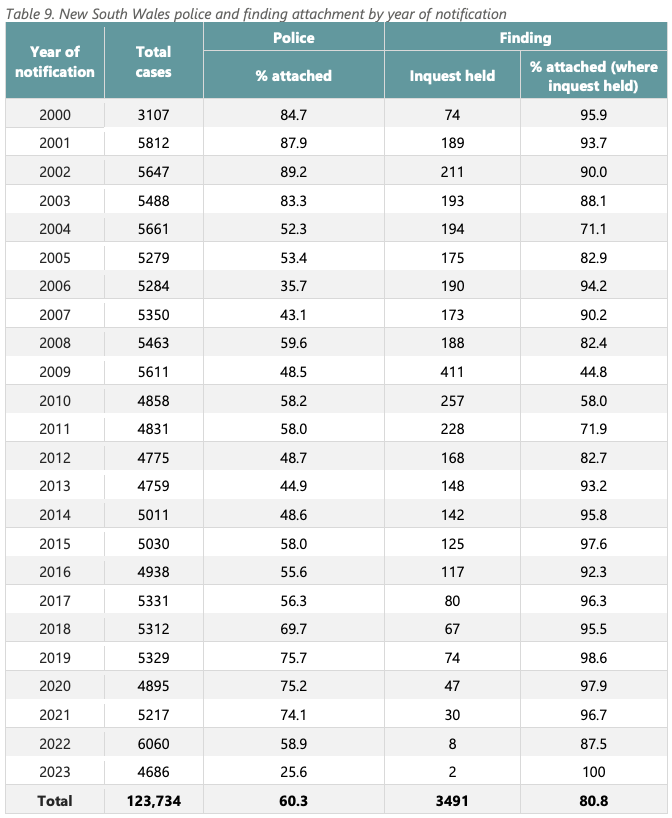
In 2021, the year Aude died, just 30 inquests were held out of the 5217 cases referred to the Coroner’s Court of NSW: a mere 0.6% of referred cases.
In 2022, when more than 25,000 Australians died compared with the 2015-19 baseline average, an inquest was held for just 0.1% of all cases.
At the time of Aude’s death, NSW Health suggested his death would be referred to the Coroner so that a cause of death could be determined. The reports quoted NSW Health in all but one of the stories with certainty: “his death was referred to the Coroner”, “will be referred to the Coroner”, “had been referred to the Coroner”, “has been referred to the Coroner”.
Based on our own enquiries, we believe those statements were false.
Disinformation theme # 5: Disinformation and misinformation was spreading on social media in relation to Aude’s death
“Ideas are more powerful than guns. We would not let our enemies have guns, why should we let them have ideas?” ~ Joseph Stalin
Propaganda’s potency is intrinsically linked with censorship, a sentiment echoed in Stalin’s quote above.
Following Aude’s death there was a brief attempt to quash “wildly circulating rumours” that Aude’s death was not due to COVID-19, or that he actually did have underlying health conditions:

The article above was the only genuine attempt by the mass media to “debunk” the alleged misinformation relating to Aude’s death that was being spread on social media. Mostly, throughout the pandemic, the mass media has simply ignored stories contrary to the mainstream narrative of the necessity of lockdowns, or the safety and effectiveness of COVID-19 “vaccines”. In the above article, the alleged misinformation included:
Aude did not die of COVID-19;
Aude had a history of heart conditions;
He was 90% healthy before he suddenly collapsed, dying of a heart attack;
The evidence presented in our article indicates that all of the above were verifiably true.
“Misinformation”, in this media report, therefore, amounted to nothing more than “wrongthink”. It was a challenge to the official narrative that Aude was a young, fit, healthy, unvaccinated man with no underlying health conditions who died from COVID-19 despite all evidence to the contrary that his mild-to-no symptoms from the infection had dissipated.
The mass media’s failure to rigorously interrogate the circumstances surrounding the death of Aude Alaskar indicates they operate as an extension of the State, rather than as an independent entity.
In this example, it was disinformation to portray these legitimate questions about the manner of Aude Alaskar’s death as “misinformation”. The disinformation tactic was employed to marginalise anyone who questioned the necessity of COVID-19 “vaccination” for young, fit and healthy people without underlying health conditions.
Conclusion
Aude Alaskar’s death was shamefully exploited to terrorise people to be vaccinated against COVID-19. The implication was that his death could have been prevented had he submitted to vaccination.
But why was Aude left to languish in his home to die?
Why was he told to not come to the hospital?
Why was he told that they couldn’t do anything to save his life?
We defer to the expert Arkmedic and implore you to read his latest piece explaining why people died of COVID-19:

Had Aude not tested positive to COVID, he would have received life-saving antibiotics to treat his condition.
He wouldn’t have been forced to isolate at home.
He wouldn’t have been told not to come to the hospital.
He wouldn’t have been told that nothing could be done.
He may have survived to this day.
But that wouldn’t have suited those who wanted to vaccinate the entire world with an experimental therapeutic.
Aude’s death was needed to amplify the fear and panic. People would only submit to vaccination if they were terrified, ignorant of their own risks with COVID-19, or ignorant of the risks with the COVID-19 “vaccines”.
From the outset of the pandemic, the mass media has largely been an echo chamber for the government narrative. This harmonised messaging serves to manufacture public consent through selective storytelling and the marginalisation of dissenting voices or contrary evidence. It has sustained a sense of crisis that justifies extraordinary governmental interventions, such as enduring lockdowns, mandates and other extreme and illiberal government interventions. In this way, mass media has served not merely as an informational platform but as a tool for shaping public opinion and legitimising state actions. There has been no evident distinction between mass media and government messaging.
Given this confluence of mass media and government narratives, it's more crucial than ever to seek out trusted, independent sources of information, or at the very least, trust nothing the government tells you.
Relative to the Sydney population as a whole.
Bath, G., “‘His Deterioration Happened Suddenly.’” The Story of Australia’s Youngest COVID-19 Victim”, Mamamia, 5 August 2021, https://www.mamamia.com.au/aude-alaskar/, accessed 17 October 2023.
Chain, B., “Family of Youngest COVID Death Victim, 27, Lash out at the ‘Slow and Confusing’ Vaccine Rollout - and Insist He Tried to Get Jabbed but there was a THREE-MONTH Wait”, Daily Mail Australia, https://www.dailymail.co.uk/news/article-9862915/Covid-NSW-Ady-Al-Askars-family-blame-slow-confusing-rollout-not-vaccinated.html, accessed 17 October 2023.
It is unclear in what capacity Yasmin worked. Some reports refer to her working in an aged-care facility, one more specifically reports her working in a “disability support” role.
Kerry Chant, quoted in Foster., A, “Twist in death of 27-year-old Covid-19 patient Aude Alaskar”, News.com.au, https://www.news.com.au/lifestyle/health/health-problems/twist-in-death-of-27yearold-covid19-patient-aude-alaskar/news-story/41af00b4dfc3eabdaaecb933402c9c93, accessed 17 October 2023.
Ibid.
Louie Alaskar, quoted in Author unknown, “Family of COVID Victim Aude Alaskar Say System Let Him Down”, The Daily Telegraph, https://archive.md/5Cur5, accessed 17 October 2023.
Bash Mnati, quoted in Hanrahan, J., Aude Alaskar, Delta’s Youngest Victim, Laid to Rest by Devastated Family”, The Daily Telegraph, https://archive.is/4an2v, accessed 17 October 2023.
Ambulance performance data for NSW can be found at this page https://www.bhi.nsw.gov.au/data-portal.
Syed, A. K., “‘There Was No Virus’…”, https://arkmedic.substack.com/p/there-was-no-virus, accessed 21 October 2023. Refer to the section on the “False Discovery Rate”.
Margo, J., “Why COVID-19 Can Be Deadly for Young People”, Australian Financial Review, https://www.afr.com/policy/health-and-education/why-covid-19-can-be-deadly-for-young-people-20210804-p58fy5, accessed 21 October 2023. A title for an article that even in 2021 would have been an oxymoron!





